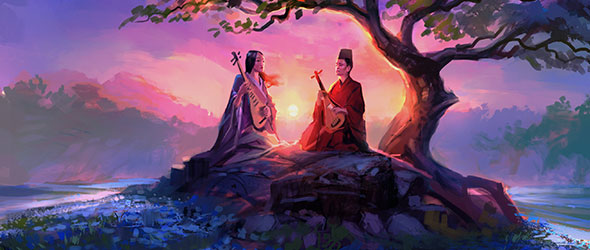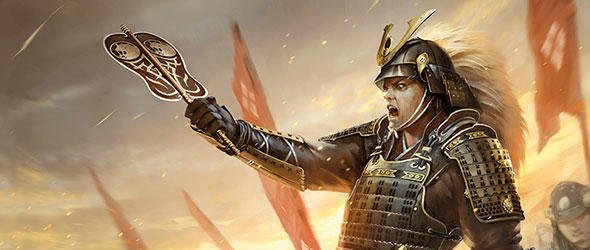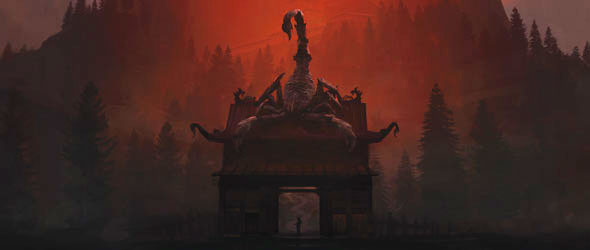How Ballroom Dancing Made Me a Better L5R Player
And You Can Too! – Guest Article by Dragon Hatamoto Alex Jacobs.

November 18, 2017 – Philadelphia, Pennsylvania. It’s close to midnight. We’ve been at the Pennsylvania convention center for sixteen hours, and I’m dead on my feet. It’s been seven rounds of Swiss and my head feels like it’s stuffed with wool. The players are tired, the TO’s are tired, my wife is patiently waiting for me, but she’s exhausted too. We all just want to go home and go to bed, but before we do, we’re waiting for The List.
Someone walks over to a stand and tapes up a few pieces of paper. We all pour in to watch it. My name’s there.
“You’re top two for the clan!” someone says. “Congratulations! You’re a Hatamoto!”

What just happened?
This wasn’t supposed to happen. When I wrote my original tournament report. I’d said that my goal for PAX Unplugged had been to go 1-3 and simply avoid a complete shutout, that even making Magistrate Stage would be a cause for celebration. So how’d I

Most of the top L5R players I’d met had either been top players in the old CCG or were top players in other games – Game of Thrones most often but a good number of Magic, X-Wing, and Destiny players as well. Stephen Didion, who went undefeated to win PAX Unplugged for the Crab, is a top-ranked X-Wing player. By contrast, while I’d played the CCG from Lotus through Celestial I was never particularly good at it and in fact I was so bad that I routinely missed out on the bottom of clan prizes; I was so bad I couldn’t even lose well. So what had happened in the past five years to change all that?
About the time my participation in the L5R CCG waned, my participation in competitive ballroom began to take off. For those who don’t know me outside of L5R, I’m a professional ballroom dance teacher. I’ve competed, have a number of first place awards, top teacher awards, and I’m a certified teacher with a rank of Master (awarded with High Honors). Also relevant, I will be judging the K-Pop dance-off at World’s this year between Melissa, Dare, and Murph. You should all donate. I’m very proud of those credentials but they’re not exactly related to card tournaments.
Or were they? Could I make them relevant? The only competitive experience I had was in ballroom competition so those were the lessons I had to draw from, at least until I learned more about cards.
I’ve talked a lot about myself and my background so far, but the primary purpose of this article is to share some of the lessons I’ve learned outside of playing L5R that can be helpful for card players. This past week I did an interview with The Sixth Ring and one of the listener questions was, “How do you feel your dancing experience assisted you in winning the Elemental Challenge at Nova?” I couldn’t go into as much depth in the interview as I’d have liked, so this article exists to explore that question in greater depth, not to pump myself up but to share an unorthodox approach to becoming a competitive player.
Let us begin the lesson.

1. Dance What You Like
Early on in my competitive dance career I made two discoveries both of which should have been rather obvious: A) The more I practice the better I place and B) The more I enjoy practice, the more I do it.
The obvious strategy then is to learn to enjoy practice, and one of the best ways to do that is work on material one enjoys. While it was absolutely essential to spend time drilling footwork and hip action and arm styling, simply putting together choreography that I enjoyed made me want to spend more time dancing it, which is also known as practice.
When it came to the card game I took the same strategy. I build decks that I enjoyed (most famously the Crane-splash dueling deck) because I knew that no matter how the game went down I’d enjoy the experience. The result was I got a huge amount of practice before PAX and NOVA Open because I never thought of it as practice; going home after work and playing three or four matches was my fun evening.

2. Know Your Strengths
I’m going to admit the truth: I’m not a very talented dancer. This isn’t the same thing as saying I’m a bad dancer, but rather it does not come naturally to me. I’m not talented. So let’s talk about talent.
The way athletic coaches use the word, ‘talent” has changed over the past several years. Previously talent was used to mean something akin to, “Skill that exists prior to training.” Take two kids out on a baseball field, have them both throw fastballs, and whoever throws faster and more accurately is more talented.
Nowadays it’s more refined. Now we use talent to mean responsiveness to training. Suppose we measure their fastball, give each of those kids an hour of pitching coaching, and then we measure their fastball again. Whoever shows the most improvement is more talented.
I like this definition because it means that skill is not a function of destiny. It’s not set; you can improve it. And in a lot of ways, it doesn’t matter if you’re talented or not because even though other people might improve faster you will still improve. But areas
When it came to
So the question to ask is what is your strength in the LCG? It can be something as simple as seeing card interactions, which sounds simple if you’re only talking deck design (and how many of us netdeck anyway?) but is absolutely essential when you have to size up your opponent’s board state when deciding what Ring to use for a Conflict or which card to discard with Kitsuki Investigator. Maybe it’s more complex like Fate management. Maybe it’s not even a skill but a mindset. Stephen was very adamant that part of the reason he won the Grand Kotei is because he had the courage to play with an empty hand while his opponents kept throwing Honor away at a losing board state. For me, it was understanding the psychology of dueling at a time in the game when most players didn’t even understand the mechanics of it.
Find your strength, however unique it is, and work it.

3. Know the Status Quo
As I said before, one of my strengths as a dancer is my choreography, particularly for the American smooth and rhythm styles which afford a great deal more freedom and interpretation than their international counterparts of standard and Latin. I love that freedom. It’s one of the reasons I fell in love with those styles, and so I got bored to tears seeing so many dancers using the same figures over and over again.
Yeah, I’m gonna make you watch a dance video. Or at least ask you to. It’s the internet and I can’t really make you do anything but I’m making a point here.
Look at the couple that enters at the left at 0:13. That figure they do where the lady turns under the gentleman’s arm, then they turn in and out as they move down the floor? That’s called a butterfly (also a face-to-face back-to-back, hand-to-hand, side-by-side change steps, patty cake, and – my personal favorite –
But wait, see the couple with the girl in the blue dress in the back at 0:17? They’re doing the same thing. And the couple with the girl in the pale dress at 0:21? Same figure. Another couple in maroon at the back at 0:31. In pink at 0:54. In maroon at 0:57. There’s more but I stopped watching. You get the point.
Why is everyone doing the same figure in a style that’s supposed to be about freedom and creativity?
I mean it’s nice, I like it, but isn’t this dull?
Well look at what’s going on here. Most of the couples sort of drift around for a long time, then they do the butterfly and all of a sudden they open up. They create shapes. They travel across the floor. And the fact is, at this level there aren’t any other figures in waltz that can do all of that. If you want to move at the same speed as (or even better, pass) everyone else, you need it. If you want to show arm styling and body shaping, you need it. People are using that figure because it’s the best tool they have at this level.
I fought for a long time against using the butterfly because it felt like a cliché to me, but once I understood what it did, understanding why to use it told me
Now when it comes to the LCG look at the top decks. Look at what they’re running. Let me be clear: you don’t need to run those cards but you do need to understand why they’re being run. I fought vehemently against running the Dragon/Crab deck (especially in Imperial) which I considered one of the
Do your own thing (remember rule 1) but understand why other players are doing their thing.

4. Judge
One of the strangest pieces of advice I got from my coach came when he told me to go judge a competition. I wasn’t hired as a judge, I had no official standing; I just went with a clipboard and a piece of paper, stood at the side of the ballroom like the real judges (you can see them in the background in that video, standing on the side of the floor), and made my own notations and scores.
It was a revelation.
Things that I thought were incredibly important ended up not mattering; I just didn’t see them. Things that I’d previously ignored caught my eye immediately. I was very pleased that at the end of the day the scores I’d recorded matched up very closely with the official scores, but what really shocked me was how many dancers came up and asked me how I scored them. Literally dozens.
“You know I’m not a judge?” I asked.
“Yeah, but how’d you score me? Why?”
Now judging a card competition is different than judging a ballroom competition. A ballroom judge is deciding who wins while a card judge is making sure the rules are followed, but the principle is two-fold here: Watch people play and let people watch you play.
It’s so easy to hop on Jigoku or Twitch and watch anyone from the top players in the world to random people no one’s heard of play; start watching. Compare their plays to what you would have done. When you disagree with a play see if it works out or not and why or why not. Then invite people to watch you play, especially in real life, and have them question your plays.
And here’s the real secret of judging: it’s not that hard. Go watch that video again from the previous section. Who’s your favorite couple there? Don’t say, “I don’t know about dancing!”. You can still pick out your favorite. Good, now you’re a judge!
Now do the same thing with cards.

5. Know Why You’re There
When I take a student to a ballroom competition I do so because I think it’s going to help them. I think there’s something that they want or need and the competition can help them get it. Here are some reasons I might take a student to competition:
- It sets a goal for them to work towards.
- The student needs experience dancing outside the studio.
- The student would enjoy winning and has a chance to do so.
Those are all good reasons but they’re all related to being a better dancer. Here are some other reasons.
- All of the student’s friends are going.
- The student likes dressing up in their dance costume.
- The student enjoys dancing all-out in a way not viable for social dancing.
When I know what the student’s goal is it affects how I train them. Someone who simply wants to put on a pretty dress and foxtrot on a big floor is going to want different training than someone who really wants to try and win something. And both attitudes are equally valid! Not every competitor needs to go in with an attitude of taking home the trophy for the weekend, but if that is your goal then you need to approach the competition with the intensity that will require, and if not then one shouldn’t begrudge people who do show up with that attitude.
A number of top players talk about the importance of having a stated goal when declaring a Conflict (or defending against one). To win a Ring, break a Province, drain resources, force a defense, all are valid, but the first goal of anyone should be, “To flip over my opponent’s Province.” This applies to competitions as well. If you’ve never competed before, especially at a Premier Event (Kotei, Grand Kotei, World’s) your first goal should be, “Go to a Premier Event.” Just see what it’s like, what the energy is like, what the experience feels like.
Anything else is gravy.

6. It’s a Marathon. And a Sprint.
I often liken ballroom competitions to a series of sprints. My first serious competition Day 1 started at 7:00 AM and we finished at 1:00 AM. Then we came back the next day. Now that’s not to say we were dancing the entire time – there were periods we had several hours free – but we had to stay ready to dance at any given time.
A typical ballroom heat has anywhere from one to sixteen couples on the floor dancing for forty-five to ninety seconds. Now if
And that is just as exhausting as it sounds.
L5R Is one of the most complex games I’ve come across because there are dozens of decision points each round; from what cards to play to how to spend one’s Fate to what to bid to commitment to Conflict to Ring choices. Which means that choosing wrong for any of them could be disastrous.
No pressure!
L5R is not usually won by any single decision but it can certainly be lost by one, which means each decision is its own sprint while altogether it’s a marathon. This is why Kotei
Sleep well the night before. Bring water or a sports drink to the venue. Pack granola bars, nuts, and other healthy high-energy food. Don’t eat crap during the tournament. Take breaks between rounds. When you get tired you get stupid and all it takes is one bad decision to lose a game. Plan accordingly.
Likewise, give yourself endurance training. Hop onto Jigoku and run seven games in a row (heck, allocate 75 minutes per game and stick to that schedule to simulate tournament rounds). Learn how your brain responds. Learn how your body responds. Don’t find these things out at a tournament.

7. Get Good Coaching
I’ve had a lot of excellent teachers in my dance career, but only a few coaches. A teacher is someone who instructs you in a skill or technique or information, but a coach is someone who molds you and shapes you over time. The process of becoming a skilled dancer is a long one with a lot of effort required, and a coach is necessary to make sure that effort produces growth.
When I coach a student today I have to take a
The point is that a coach can look a long term goal and create an incremental plan to achieve it.
If your goal is to win a Kotei (or a Grand Kotei or World’s or the Discord League or anything else), ask someone to be your coach. They don’t need to be a top player, though they should understand the game. Have them come up with a series of intermediary steps for you. Test your decks with them. Have them watch you play and give you feedback during and after the game.
And do the same for other players if they ask you.

8. Get Out of Your Comfort Zone
There are four main styles of ballroom dancing (American smooth, American rhythm, International Standard, and International Latin) as well as other more focused styles (country-western, nightclub, vintage, etc.). Of them all my favorite style is American smooth. Of the smooth dances (waltz, tango, foxtrot, Viennese waltz, and Peabody) my favorite is waltz. And yet when I competed I competed in all of the other styles and dances.
Why?
On the
Oh, I’m careful not to give people too many dances to learn at the beginning, but initially I want people focusing on three or four most popular dances. While part of this is because I want them to be able to dance with other people if asked, the real purpose is because the first year someone is taking dance lessons they’re not learning how to dance; they’re learning how to learn.
Most of us spend a lot of time sedentary; we have stationary jobs, we sit on a couch and watch TV, we gather around a table and sling cardboard, we read exceedingly intelligent articles on the internet. These are all good uses of one’s time but what they don’t do is prepare one to dance, so for that first year I’m teaching people how to use their body, how to connect physically to another person, how feet are connected to movement, and what causes arms to move the way that they do. And I couldn’t care less whether those lessons come from waltz or cha cha, tango or salsa, hustle or polka. We’re having the same lesson either way, but I’ll use different dances to teach that lesson so that I can approach it in a different way.
If one needs to understand Fate management then play Scorpion. If one needs to understand card management then play Crane. If one needs to understand character management then play Lion. If you disagree with any of these assessments, fine! Go ahead and find the deck that lets you practice that Skill. But it may not always be (probably won’t be) your deck and Clan, and that’s important because even if you understand how that skill is employed in your deck, other decks will employ it differently. Be prepared for that.

9. Dance What You Like
This again. It’s that important.
So much of my dance career was about breaking out of my habits, but in the
It’s the same for the cards. If your only goal is to win tournaments there’s some solid advice here, on this website, and really all around. But we don’t play games purely to win, we play them to enjoy them. Now winning is fun for most people, but as I tell my students at competitions, only one couple gets to win so everyone else who shows up better
Find what it is about the game that you love. Maybe it is running the most powerful deck you can as well as possible, but maybe there’s something else. Maybe you like pulling off crazy combos. Maybe you like that moment when a game comes down to a single Conflict. Maybe you enjoy deck building. Maybe you just like going to tournaments and the atmosphere they bring out (community atmosphere I mean. Gamer funk is real). Maybe you have a favorite card that you just like getting to use.
Play it.
I always enjoyed practice more when I was excited about the material we were working on. That’s true whether I’m talking about dance or cards. Even after winning NOVA Open with my take on Dragon/Crab, I’m still playing my Dragon/Crane deck in the Discord League just because I really enjoy it; when the game is fun I never regret my time playing it.
Enjoy every match.
I’ll see you on the floor.
Acknowledgments
This article is an outgrowth from a listener question during an interview on The 6thRing Podcast. It was also inspired in part by “How Starcraft Helped My Dancing” which is basically this article, but
If you have any comments or feedback please post them in the comments section below. Join us on our Twitch stream every second Monday at 8pm BST, 9pm CEST, 1pm PST.
Check us out on the Imperial Advisor website, podcast, and YouTube channel for more discussion about the L5R LCG.

5 Replies to “How Ballroom Dancing Made Me a Better L5R Player”
Fantastic read! Thanks for taking the time to write it.
Glad you enjoyed it! Thanks for taking the time to read it and the kind response.
Love this, please write more like this again in the future!
Last but not least, it is important to update operating your website frequently with fresh and relevant content.
But its this same requirement that your viewers they fit in, in which means
you know that there is someone there. http://Www.Last-Minute-Rentals.Co.uk/connect/o.php?out=http://jom.fun/
Interesting stuff to read. Keep it up.